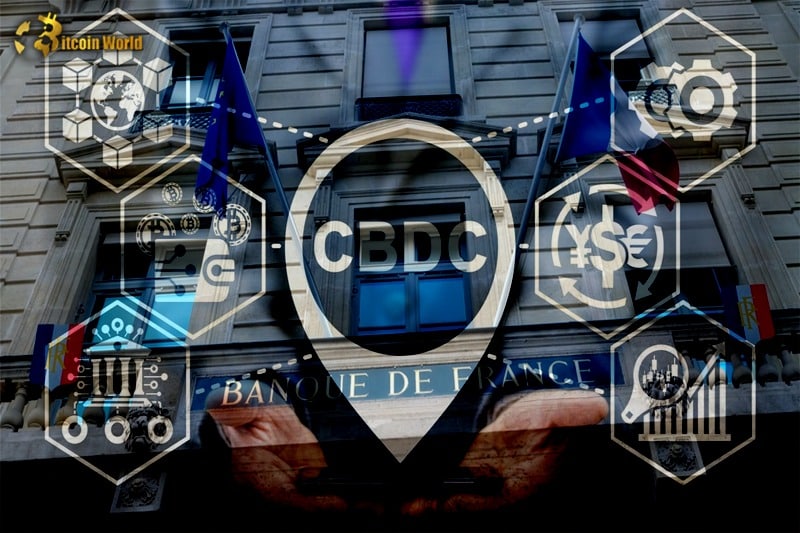Are you ready for a financial revolution? Imagine a world where sending money across borders is as seamless as sending an email. That’s the vision French central bank, Banque de France, is championing with Central Bank Digital Currencies (CBDCs). They’re not just seeing CBDCs as a domestic upgrade, but as the very building blocks of a brand new international monetary system. Let’s dive into why this is a game-changer and what it means for the future of global finance.
Why is the French Central Bank Pushing for Global CBDCs?
According to Denis Beau, the first deputy governor at Banque de France, CBDCs are more than just a digital form of cash. He boldly stated that they are “the catalyst for improving cross-border payments by enabling the build-up of a new international monetary system.” This isn’t just about making payments faster; it’s about fundamentally rethinking how money moves around the world.
Beau emphasizes a crucial point: cross-border functionality shouldn’t be an afterthought in CBDC development. It needs to be baked in from the very beginning. Think of it like building a house – you don’t decide on the doors and windows after the walls are up, you plan for them from the start. Similarly, for CBDCs to truly transform the global financial landscape, international interoperability is paramount.
The Roadmap to a Global CBDC System: What are the Options?
So, how do we get from national CBDC discussions to a global system? Beau outlines a couple of key pathways:
-
Common Standards and Interoperability: This first path focuses on ensuring that different wholesale CBDCs (used by financial institutions) can talk to each other and work seamlessly with existing financial systems. Imagine different countries adopting similar ‘plugs and sockets’ for their digital currencies. This would allow for smoother connections and transactions.
-
Regional or Global CBDC Platforms: This more ambitious approach, supported by organizations like the International Monetary Fund (IMF) and the Bank for International Settlements (BIS), envisions creating shared platforms for CBDCs. Think of it as building international highways specifically for digital currencies. These platforms could:
- Standardize wholesale CBDCs for direct exchange.
- Facilitate Payment versus Payment (PvP) – ensuring that both sides of a transaction are settled simultaneously, reducing risk.
- Enable Delivery versus Payment (DvP) – crucial for securities transactions, ensuring that the transfer of assets happens only when payment is confirmed.
Project Mariana: A Glimpse into the Future of CBDCs
To illustrate the potential of these platforms, Beau highlighted Project Mariana. This groundbreaking initiative, involving Banque de France, the Monetary Authority of Singapore, and the Swiss National Bank, explored the use of an automated market maker (AMM) for CBDCs.
What is an Automated Market Maker (AMM)?
In simple terms, an AMM is a decentralized exchange protocol that uses algorithms to automatically set prices and execute trades, eliminating the need for traditional intermediaries. Think of it as a robot market maker for currencies.
Project Mariana’s Success:
Completed in late September, Project Mariana successfully demonstrated how AMMs could work with CBDCs, paving the way for more efficient and potentially cheaper cross-border transactions. This project offers a tangible example of the innovative possibilities within a global CBDC framework. You can explore more about this project and CBDCs in general here.
Tokenization of Finance: CBDCs and Beyond
The French central bank’s vision extends beyond just CBDCs. Beau also touched upon the broader trend of tokenization in finance. Tokenization is the process of representing real-world assets – from stocks and bonds to real estate – as digital tokens on a blockchain.
Public and Private Sector Collaboration:
Beau believes that the public sector has a vital role to play in supporting private sector innovation in blockchain and tokenization. This support is crucial for unlocking the full potential of these technologies while also managing and mitigating potential risks. It’s about creating a balanced ecosystem where innovation can flourish responsibly.
CBDCs and Tokenized Assets: Allies, Not Competitors
A key takeaway from Beau’s perspective is that tokenized “central bank money availability” (CBDCs) and tokenized assets are not in competition. Instead, he sees them as complementary forces. CBDCs can provide a trusted and stable digital foundation for the tokenized economy, facilitating smoother and more secure transactions of tokenized assets.
The Future is Digital and Global
The message from the French central bank is clear: CBDCs are not just a domestic affair; they are a global opportunity. By embracing a global perspective and focusing on interoperability and shared platforms, we can unlock the transformative potential of CBDCs to create a more efficient, inclusive, and innovative international monetary system. It’s a bold vision, but one that is increasingly gaining traction on the world stage. As we move further into the digital age, the groundwork laid by initiatives like Project Mariana and the forward-thinking approach of central banks like Banque de France will be crucial in shaping the future of global finance.
Disclaimer: The information provided is not trading advice, Bitcoinworld.co.in holds no liability for any investments made based on the information provided on this page. We strongly recommend independent research and/or consultation with a qualified professional before making any investment decisions.


